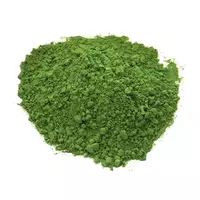Matcha green tea

The Japanese love versatile and multifunctional things. For example, Japanese matcha green tea, which is considered not only the national drink of the country of the Rising Sun, but also the ingredient in confectionery and other dishes. Currently, this powdered green tea is incredibly popular. And not only among the inhabitants of Japan. Matcha green tea received its original name thanks to the phrase 抹茶, which literally means "crushed tea" in Japanese.
The history of matcha green tea, like other powdered teas, dates back to the Chinese Tang dynasty, which ruled from 618 to 907 AD. It was in those distant times that the Chinese were the first to come up with an excellent way to transport and store such an important drink as green tea. The tea leaves were steamed, then pressed into neat briquettes. The tea leaves were then triturated and boiled with boiling water with the addition of mint and salt. From about the 13th century, powdered tea began to be made from pre-dried tea leaves. Moreover, the tea was no longer pressed.
Matcha green tea entered Japan from China. The drink was a mandatory component of some rituals among Zen Buddhists. The monk Eisai in 1191 brought matcha green tea to Japanese lands. Subsequently, Eisai founded the Rinzai school of the Japanese branch of Zen Buddhism. However, the master entered Japanese history not only as the founder of the school of Zen Buddhism, but also as a popularizer of tea among the inhabitants of Japan. It was Buddhists who instilled in the Japanese love and respect for tea. Such a reverent attitude towards the oldest tea drink makes two great countries Japan and China related.
Matcha green tea is produced from pre-darkened tea leaves. This is a distinctive feature that is inherent only in matcha green tea. A few weeks before the harvest of green tea, the leaves are covered with special covers that do not let in the sun's rays. This is the process of darkening tea in action, then the leaves are collected and dried. It is noteworthy that it is the process of darkening matcha green tea that helps to saturate the chemical composition of the drink with amino acids, vitamins, minerals and other biologically active elements necessary and indispensable for the human body. Matcha green tea refers to high-end and expensive teas.
However, this tea is worth it. Matcha green tea retains all useful natural compounds that completely enter the human body. The thing is that when brewing ordinary tea, some of the useful chemicals remain in the brew, which is not consumed. Powdered teas are precisely distinguished by the fact that all useful compounds that are part of the drink enter the human body. In addition, recent studies have found that matcha green tea contains seven times more natural antioxidants than natural black chocolate, 17 times more than blueberries, and 60 times more than spinach.
matcha green tea 1 kCal
Energy value of matcha green tea (Ratio of proteins, fats, carbohydrates - ju):
Proteins: 0 g (~ 0 kCal)
Fats: 0 g (~ 0 kCal)
Carbohydrates: 0.2 g (~ 1 kCal)
Energy ratio (b | y): 0% | 0% | 80%
 Español
Español Français
Français Português
Português Русский
Русский 简体中文
简体中文 繁體中文
繁體中文 日本語
日本語 한국어
한국어 العربية
العربية Türkçe
Türkçe Қазақ
Қазақ Deutsch
Deutsch Italiano
Italiano Українська
Українська
